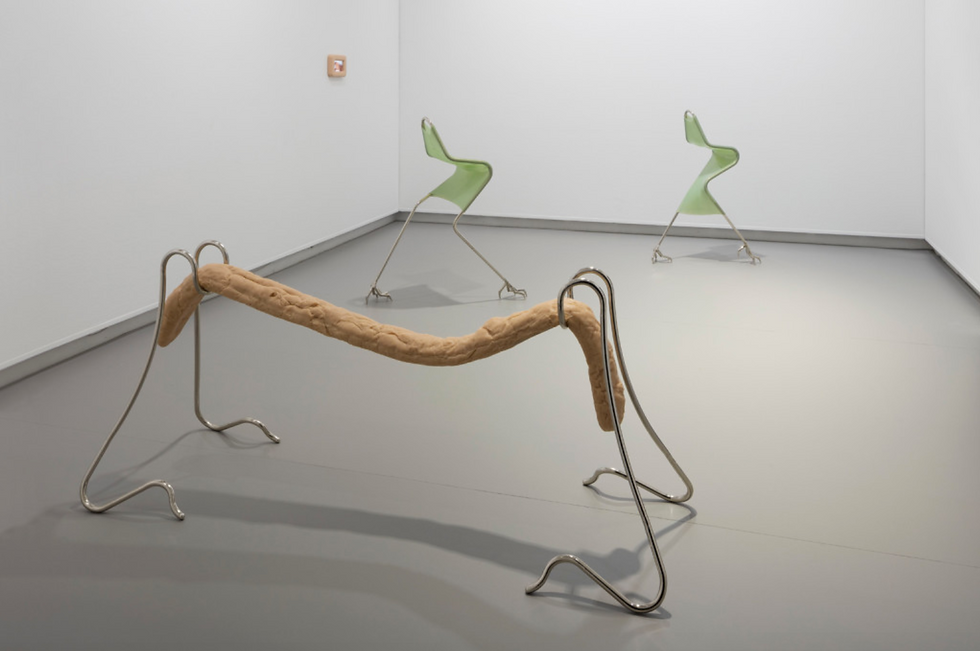Three young women sculptors who explore metamorphosis and transformation in their works
- Yoann Guez
- Mar 24, 2022
- 3 min read
This week, we wanted to make you discover the work of Hanna Levy, Ivana Basic and Marguerite Humeau, three women sculptors in their thirties who have created profoundly unique bodies of work in recent years. Despite their differences, they share a fascination for shapes—organic or not—in transformation. Each in their own way, all three masterfully capture the process by which living creatures and inanimate objects change their appearance over time, thus producing new possibilities and meanings. Aesthetically, they also share a keen eye for detail as well as a taste for precise materials with a smooth surface finish.

1) Ivana Basic

Ivana Basic is a Serbian-born artist based in New York. She studied art in Belgrade before moving to the United States in 2010. There, she began creating sculptures that explore the endless cycles of life and death through multiple metamorphoses.
Basic grew up during the Yugoslav Wars in the 1990s, which would have a major impact on her works. “Being exposed to an acute reality of death… that moment where life turns to matter, that is what I’m on the quest for” said the artist in a recent interview for AQNB magazine. Indeed, her sculptures are based on organic shapes that appear suspended in this process. While some of her works represent gloomy anthropomorphic characters curled up in weird positions, the artist also reveals the creative potential of death by drawing inspiration from natural processes such as the transformation of a caterpillar into a butterfly. She mainly uses oil-painted wax to create her strange shapes and generates contrast by adding materials with opposite properties and aspects such as blown glass or metal.

Ivan Basic is represented by Marlborough Gallery in New York. She has exhibited in numerous art spaces mainly in Europe and the United States, including the prestigious Whitney Museum in New York, which holds one of her sculptures in its permanent collections.
2) Hannah Levy

Hannah Levy is an American artist born in 1991. She started her career as a sculptor in 2013 after graduating from the prestigious Cornell university in fine arts. From early childhood, Levy was fascinated by industrial design until she found a way to turn manufactured objects into art.
In her work, Hannah Levy reproduces a vast variety of artefacts related to human consumption—from expired food to medical equipment and clothes—and takes them out of context. The artist often uses sharp-edged metal structures to deform or present these objects in entirely new ways, thus freeing them from any pre-conceived meaning. The rigidity of polished steel contrasts with her soft silicon shapes whose color is very close to caucasian skin. This accentuates the strangeness and the transformative aspect of her objects. Levy uses the term “design purgatory” to refer to her artistic practice.

The artist is represented by New York-based gallery Casey Kaplan, which organized her last solo exhibition in 2020. Her works have been exhibited in important institutions worldwide such as MoMA PS1 in New York or le Palais de Tokyo in Paris.
3) Marguerite Humeau

Marguerite Humeau is a French artist living and working in London. She studied design at the prestigious Royal College of Art where she learned modern sculpting techniques. Her works are inspired by her wide range of interests from zoology to cinema and the history or art.
Humeau is primarily known for her sculpture representing hybrid shapes inspired by organic features. The latter are conceived by the artist thanks to a 3D software. A team of technicians then oversees the creation of the work using an automatic subtractive method as opposed to 3D printing, which adds material layer upon layer. This technique allows her to bring out precise forms with a mixture of polystyrene, polyurethane resin and fiberglass on a metal skeleton, which gives a futuristic aspect to her pieces. But Humeau’s work goes far beyond her sculptural practice. The artist incorporates exotic objects, scientific experiments—from an elephant tear to a rose carpet soaked in all the chemical compounds of the human body—and sound textures, thus transforming her exhibitions into multimedia experiences. According to her, the process of investigating these areas of knowledge is as important as the works themselves.

Marguerite Humeau is a renowned artist who has exhibited in some of the world’s most prestigious institutions. In 2016, she had her first major solo museum show at the Palais de Tokyo in Paris, followed by another solo exhibition at the Tate Britain in 2017. Her work is shown in major art fairs around the world thanks to her gallery C L E A R I N G.




Comments